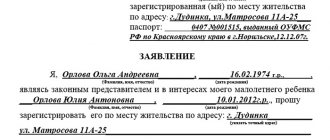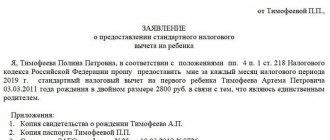Author of the article: Yulia Kaisina Last modified: January 2021 4913
The Family Code establishes that the priority form of placement for children without legal parents is adoption. This procedure is long and involves the collection of a huge number of various documents that allow it to be carried out. However, if a biological parent who is not married to the child's mother wishes to acknowledge paternity, it is somewhat simpler and does not require the submission of all documents necessary for adoption. Let's take a closer look at how a father can adopt his child.
What is adoption
As a general rule, adoption is considered a legal act that establishes between the parties to such adoption personal and property relations characteristic of natural parents and children. As a rule, it is carried out in relation to children deprived of parental care, however, the adoption of a wife’s child from her first marriage is no less common in legal practice.
According to Art. 124 of the Family Code of the Russian Federation, adoption is possible only for children under 18 years of age, so it will not be possible to adopt an older stepdaughter.
The main feature of adoption is the emergence of not only close family relationships, but also legal consequences expressed in property, housing, inheritance and other rights. In return, the stepfather-adoptive parent can change the child’s personal data and receive a new birth certificate.
At the same time, the adopted child, according to Art. 137 of the Family Code, even while the father is alive, is deprived of any personal or property rights and obligations in relation to him and his relatives.
A publication entitled “Adoption” will help you learn more about this.
Adoption of a biological child by a father
Often, at the birth of a baby, information about the father is not included in the certificate. This may be dictated by the lack of official relations between partners or the man’s reluctance to recognize the baby. Also, spouses can obviously make a similar decision, because the status of a single mother allows them to receive increased benefits. However, this ultimately leads to the fact that the father is deprived of all rights and responsibilities towards the offspring.
Adoption is understood as a procedure during which the obligations for raising and maintaining a child, as well as caring for him, are assigned to a stranger. Registration of the appropriate status is possible when biological parents are deprived of their rights or have died. Thus, the procedure is typical for the arrangement of persons left without the care of their mother and father. For this reason, calling the acquisition of official status by a natural father adoption is not entirely appropriate.
Important! The process of obtaining rights and obligations in relation to a natural offspring is correctly called establishing paternity. So, it makes no sense for a biological father to adopt his child.
Establishing the fact of paternity is a legal term that reflects a legally established procedure carried out through the registry office (sometimes with the involvement of a court). Adoption is allowed only if the man deliberately intends to hide his blood connection with the offspring. In the latter case, it will acquire the corresponding status after a lengthy procedure, for which the legal acts are subject to much greater requirements.
The legislative framework
The legal regulation of the adoption procedure in Russia is carried out by several legal acts at once. Thus, the basis of the regulatory framework is Chapter 19 of the Family Code, which establishes the criteria for the parties to adoption, the main conditions and procedure, legal consequences, and the possibility of canceling the adoption.
The procedure for judicial review of such cases is determined by Chapter 29 of the Civil Procedure Code, which describes the nature of the trial, methods of filing an application, its form and the composition of the required package of documents, further procedures, etc.
In addition, it is necessary to introduce into the legislative framework the “Rules for the transfer of children for adoption”, approved by Decree of the Government of the Russian Federation No. 275 of March 29, 2000 (hereinafter referred to as the Rules), and certain provisions of the Civil Code concerning the legal consequences of adoption.
All other regulations related to adoption in one way or another regulate the procedure for adopting orphans, which the wife’s child is definitely not.
Conditions for adoption by a stepfather or stepmother
After marriage, the husband of the child's mother becomes the final stepfather. He, as a rule, strives to perform the functions of a father, which nevertheless does not give him parental rights. To do this, you need to go through the adoption procedure.
It is important to understand: in order to adopt a child of a husband or wife, the desire of the adoptive parent and the initiative of the spouse are not enough.
For the smooth passage of this procedure, it is necessary to comply with a number of conditions based on logic and legal norms. These are, in particular:
- the presence of the will of the adoptive parent himself to adopt;
- compliance of the adoptive father with the requirements established by Art. 127 SK;
- the consent of the child’s biological father, if he exists, is recorded on the birth certificate as the child’s father and he retains parental rights;
- consent of the child himself, if he has reached the age of 10;
- consent of the child’s mother – the adoptive parent’s spouse.
It should also be noted that a mandatory condition for a man is to adopt a child after marriage with his mother and vice versa. Being in cohabitation without registering the relationship in the registry office does not make a man the stepfather of a child and, therefore, does not give him the right to adopt the offspring of his cohabitant. Even if close friendly relations have been established between a child and a man, adoption is impossible without marriage with a woman - the mother of a potential adoptee.
Alternative to adoption
However, if she is a single mother, and there is a dash on the child’s birth certificate, instead of adoption, the law allows for a procedure to establish paternity. The upcoming legal consequences are essentially the same, but the procedure itself is radically different.
So, according to Part 3 of Art. 48 of the Family Code, recognition of a person as the father of a child in the absence of a registered marriage between him and the child’s mother is carried out by the civil registry office upon a joint application submitted by these persons.
All that is needed for adoption through the registry office is a passport, a joint application with the child’s mother and a personal appearance at the registration authority. From the moment the registration authority changes the civil status act, the man has the rights and responsibilities of the child’s blood father, even if he is not one.
It should be understood that when paternity is established, a man does not acquire the status of an adoptive parent, but is recognized directly as the blood father of the child, although this does not provide for any legal differences in relations with the child. But, on the other hand, in contrast to adoption, recognition of one’s own paternity through the registry office in relation to someone else’s child, when this is known to such a person, according to Part 2 of Art. 52 IC, deprives him of any right to challenge such paternity.
Through the registry office
The easiest way is to recognize paternity administratively (through the registry office).
This is possible if the birth certificate contains a dash in the “father” column. A man who considers himself a father can contact the registry office and apply for recognition of paternity.
Let's consider two scenarios for administrative recognition of paternity...
- if the common-law wife agrees;
- if the common-law wife cannot express consent (she died, was deprived of parental rights, went missing, lost her legal capacity).
With the consent of the common-law wife
If a woman agrees for a man to recognize himself as the father, the two of them must visit the registry office together and submit a joint application (clause 3 of article 48 of the RF IC).
An application to the registry office, which is submitted by a man who considers himself a father, together with his mother (form No. 12), contains the following data:
- data of the father and mother (full name, date of birth, place of residence, citizenship);
- child’s details (full name, date of birth, gender);
- data of the civil registry office, date and number of the child’s birth certificate;
- request: to register the procedure for establishing paternity;
- desired details of the child (full name) after recognition of paternity;
- signatures of mother and father.
The application must be accompanied by:
- father's passport;
- mother's passport;
- child's birth certificate;
- consent of the child (if he is over 10 years old);
- receipt for payment of state duty.
Important! There is no need to prove the origin of a child from a man who wants to recognize himself as the father. There is also no need to invite witnesses or conduct a genetic examination. To establish paternity it is enough...
- father's intentions;
- mother's consent;
- consent of the child if he is over 10 years old.
As you can see, submitting a joint application to the registry office is much easier than carrying out the adoption procedure.
Without the consent of the common-law wife
If a woman cannot give consent (died, deprived or limited in parental rights, missing) - this is not an obstacle to the administrative recognition of paternity. Documentary confirmation of one of the listed circumstances will allow the father to individually apply to the registry office and recognize paternity without the mother (clause 3 of article 48 of the RF IC).
True, before contacting the registry office, the father must first obtain permission from the guardianship and trusteeship authority - the municipal body that monitors compliance with children's rights. To do this, you need to contact the PIO at the child’s place of residence and submit an application drawn up in a free form or in a form approved by the local authority, indicating in it information about yourself, about the mother who cannot give consent to establish paternity, about the child, whose father the man considers himself to be. The OOP typically provides consent within 30 days.
Having received the consent of the guardianship and trusteeship authority, you can contact the registry office.
An application to the registry office, which is submitted individually by a man who considers himself a father (form No. 13), contains the following data:
- data of the father and mother (full name, date of birth, place of residence, citizenship);
- child’s details (full name, date of birth, gender);
- data of the civil registry office, date and number of the birth certificate;
- reasons for filing a single application (information about the death of the mother, deprivation of parental rights, deprivation of legal capacity, recognition as deceased or missing);
- details of the supporting document: date and number of the court decision or act record;
- request: to register the procedure for establishing paternity;
- desired details of the child (full name) after recognition of paternity;
- father's signature.
The following documents must be attached to the application:
- passport;
- child's birth certificate;
- documentary evidence of the mother’s absence (death certificate, court decision depriving the mother of parental rights, deprivation of legal capacity, declaring missing or deceased);
- consent of the PLO;
- consent of the child (if he is over 10 years old);
- receipt for payment of state duty.
Procedure for adopting a wife's child
The procedure for adopting a wife’s child is, although simplified compared to the adoption of an orphan, but also a lengthy bureaucratic process associated with passing through a number of authorities. Thus, the procedure for adopting a wife’s child by a stepfather in Russia requires going through several stages, including:
- Obtaining consent from all interested parties from whom it is required by law.
- Collecting the necessary package of documents, which will be discussed below.
- Submitting an application and collected documents to the guardianship and trusteeship authorities at the child’s place of residence.
- Obtaining a conclusion on the possibility of being an adoptive parent from the guardianship authorities.
- Submitting an application for adoption and the necessary documents to the court at the child’s place of residence.
- Obtaining a positive decision and state registration of adoption.
As a result of the adoption, if the adoptive father so desires, in accordance with Articles 134, 136 of the Family Code, he has the right to be recorded as the blood father in the birth certificate, as well as to give the child his patronymic and surname.
A publication on the topic “Adoption Procedure” will help you learn more about this process.
Required documents
Before adopting the child of his wife - a single mother, the potential adoptive parent will have to collect 2 packages of documents: one each for the guardianship authorities and one for the court. Although a simplified set of documentary grounds is provided for stepfathers, time will still have to be spent.
Thus, in accordance with clause 6 of the Rules approved by Decree of the Government of the Russian Federation No. 275 dated March 29, 2000, the guardianship authorities must submit:
- autobiography;
- a certificate from your place of employment indicating the amount of income;
- confirmation of ownership of housing;
- certificate of no criminal record;
- health certificate;
- a copy of the mother's marriage certificate;
- application with a request to issue a conclusion on the possibility of becoming an adoptive parent.
To the court, in turn, in accordance with Part 1.1 of Art. 271 of the Civil Procedure Code, you must submit:
- adoption application;
- a copy of the mother's marriage certificate;
- medical report on health status;
- documentary evidence of the right to use or ownership of housing.
All specified documents are submitted in two copies.
The article on the topic “What documents are needed to adopt a child” will tell you more about them.
Consent for adoption
In addition to other documents and permits, adoption consents occupy a central place, which must be obtained from:
- wives - mothers of the child being adopted;
- biological father, if he is not deprived of parental rights and is recorded on the birth certificate;
- the child himself, if he is 10 years old.
According to Art. 129 of the Family Code, the mother’s consent to the adoption of a child by the stepfather, like the consent of the blood father, can be given in the form of a notarized statement or stated directly at the court hearing. Moreover, such consent can be expressed in relation to a specific person or without indicating him. In addition, the law allows the parent who has given such consent to withdraw it, but only before a court decision is made.
We note that, according to Art. 130 IC, the consent of the blood father is not required if he:
- unknown or missing;
- incapacitated;
- deprived of parental rights;
- evades parental responsibilities for reasons recognized by the court as disrespectful.
The publication “Consent to Adoption” will help you learn more about conciliation procedures.
If the father doesn't agree
If voluntary consent to the adoption of the wife's child was not obtained from the blood father, there is practically no chance of a positive outcome. Moreover, if the father does not shirk his legal responsibilities for the maintenance and upbringing of the child, in this case the stepfather is deprived of the opportunity to become an official father.
Another question is if the father does not participate in the maintenance of the child, evades paying alimony, and also does not communicate with him and does not participate in his upbringing for more than six months. In this case, Art. 130 of the Family Code gives the stepfather the right to ask the court to carry out the adoption without the consent of the blood parent, even if he deliberately expressed his disagreement.
Another, longer and more expensive option that avoids the need to obtain the father’s consent is deprivation of his parental rights. The grounds for this, according to Art. 69 IC, may arise even if he participates in the maintenance of the child and sees him, but:
- abuses parental rights;
- abuses a child;
- is sick with alcoholism or drug addiction;
- committed a crime against the health and life of children, the second parent or his spouse.
Cases of deprivation of parental rights are considered by the court; In case of a positive decision, the consent of the blood father for adoption will not be required.
The court's decision
After submitting an application for adoption to the court, it considers the case essentially in a closed session as a special proceeding. Due to the need to study all the circumstances of the case, the legislation does not provide for specific deadlines for its consideration.
If the outcome of the case is positive, the court, guided by Art. 274 of the Code of Civil Procedure, makes a decision that satisfies the stepfather’s request for adoption.
In it, the court, if necessary, indicates a change in the child’s patronymic and surname, the need to enter the stepfather in the civil status act as a father, as well as a change in the time and place of birth.
The said decision comes into force 10 days after its adoption in the absence of an appeal from interested parties. From that moment on, the stepfather has the rights and responsibilities of a father. Over the next three days, the court must send a copy of the decision to the registry office, which will carry out state registration of the adoption.
Why can they refuse?
It is worth noting that the consideration of an adoption case by a stepfather is often, although formal in nature, but the court, nevertheless, having grounds for this, is quite capable of refusing adoption. In particular, the reason for refusal may be:
- absence of one of the mandatory consents specified above;
- non-compliance of the adoptive parent with the requirements provided for in Art. 127 SK (poor health, criminal record);
- the contradiction of adoption to the interests of the child, established in the conclusion of the guardianship authority.
Refusal to adopt is also formalized by a court decision, which can be appealed within 10 days from the date of its issuance.
Documents to establish paternity in court.
If for some reason you still had to resort to going to court to establish paternity, then you need to do the following:
- 1. Prepare a claim in which you present all the arguments in favor of the fact that you are the real father of the child.
- 2. Pay a state fee of 300 rubles.
- 3. Attach supporting documents. It can be:
- a. Photographic materials;
- b. Explanations of witnesses;
- c. Results of genetic testing.
After you have submitted all the materials on the case, the court first schedules preparation and then trial.
If the evidence you provide is enough for the judge to form a final opinion and confidence that you are right, then in many ways the process will be formal in nature and consist of a simple formal confirmation of an existing fact.
Arbitrage practice
Reviews of judicial practice do not single out cases of adoption of a wife's child by a stepfather into a separate category of cases, even though a simplified procedure for consideration is in some sense provided for them. In fact, it consists only of a shortened list of documents that a potential adoptive parent must submit to the court.
The judicial review itself, although it takes place in a general manner, is distinguished by a certain formality, since the desire to adopt the wife’s child is embodied in the adoption procedure, as a rule, only in the practical absence of any obstacles to this.
Studying court decisions on adoption from open sources, we were not able to find a single judicial act where stepfathers or stepmothers were denied adoption. Based on this, we can draw the obvious conclusion that such requests from stepfathers and stepmothers are almost always granted by the courts. This, in turn, excludes any judicial practice of appealing negative court decisions. Although, it is likely that exceptions are possible.










